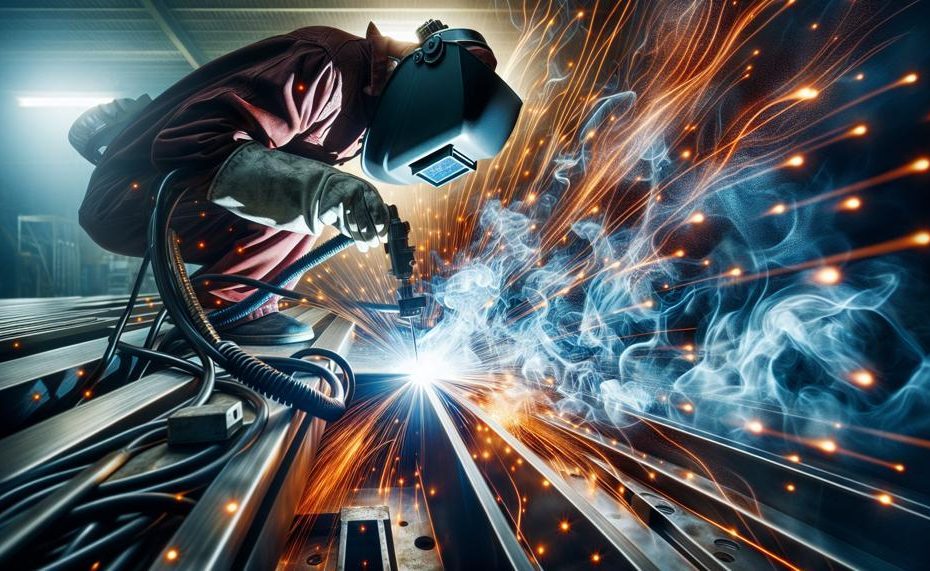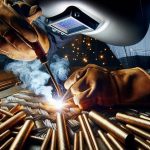Is your MIG welder acting up and surging uncontrollably? Take a deep breath, my fellow welder. You’re not alone in this struggle. Surging is a pesky problem that plagues many of us, and it can be caused by various factors.
But don’t throw in the towel just yet. Let’s roll up our sleeves and figure out why your MIG welder is surging.
In this blog post, we’ll delve into the world of surging MIG welders and provide you with some helpful tips to troubleshoot and fix the issue.
So, grab your favorite beverage and join me as we unravel the mystery of surging MIG welders. Here’s what we’ll cover:
- Defining surging in MIG welders
- Identifying common causes of surging
- Step-by-step troubleshooting guide
- Pro tips for preventing future surges
Contents
- 1 Top Reasons for MIG Welder Sputtering: Identifying the Issues
- 2 Why is my MIG welder surging?
- 3 Troubleshooting Sputtering: Best Fixes for Common Issues
- 4 Mastering MIG Welding: Preventive Measures to Avoid Sputtering Issues in Future
- 5 Mastering MIG Welding: Preventive Measures to Avoid Sputtering Issues in Future
- 6 Conclusion
Top Reasons for MIG Welder Sputtering: Identifying the Issues
MIG welder sputtering is a prevalent problem that can be frustrating and affect the quality of your welds. It occurs when the welding wire does not melt or transfer smoothly, resulting in an uneven and spattered bead.
There are numerous potential causes of MIG welder sputtering, including inconsistent wire feed speed, poor ground connection, inadequate shielding gas, impurities in the base metal, damaged contact tips, excessive resistance or poor conductivity of electric current, and contaminated components.
Identifying these issues requires close observation of the welding process. Look for signs of wear or damage on the equipment, as well as any irregularities in the weld bead.
Inconsistent wire feed speed can result in an uneven weld bead and weaken the weld’s strength.
A poor ground connection can lead to an unstable arc and cause sputtering. Low pressure or incorrect mixing of shielding gas can also cause sputtering.
Impurities on the base metal can negatively impact the welding process and must be thoroughly cleaned before welding. Damaged contact tips can cause erratic wire feeding and unstable arcs, resulting in sputtering.
High-voltage surges and sputtering can occur due to excessive resistance or poor conductivity of electric current.
Lastly, contaminants on welding components can burn or outgas during welding, causing sputters and potential damage to the equipment.
Why is my MIG welder surging?
MIG welders can experience surging, which is an abrupt rise and fall in welding current. This can cause problems with the weld quality and can be frustrating for the welder.
There are a number of factors that can cause MIG welder surging, including:
| Problem | Possible Cause | Solution |
| Dirty or corroded welding wire | Contaminants on the welding wire can interfere with the electrical conductivity, causing the welder to surge | Clean the wire feeder and replace the welding wire |
| Incorrect welding parameters | The welding voltage, wire feed speed, and travel speed should all be set correctly for the type of metal being welded and the desired weld quality. If the parameters are not set correctly, the welder can surge | Refer to the manufacturer’s instructions for the recommended welding parameters |
| Poor electrical connections | Loose or corroded electrical connections can cause the welder to surge. Ensure that all electrical connections are tight and clean | Inspect the electrical connections and tighten or clean them as necessary |
| Faulty welding equipment | A faulty welding machine or wire feeder can cause the welder to surge. If the welder is still surging after trying the other troubleshooting steps, it may need to be repaired or replaced | Contact a qualified technician to repair or replace the faulty equipment |
Troubleshooting Sputtering: Best Fixes for Common Issues
Sputtering is a common issue that can occur while MIG welding. This can be caused by various factors such as excessive resistance, dirty components, low gas flow, and worn contact tips and liners.
To ensure a smoother welding experience and stronger joints, it is important to address these issues promptly with the following solutions:
Excessive resistance/poor conductivity:
- Check the welding gun and cable for any signs of damage or wear and tear. This could include kinks, frayed wires, or loose connections.
- Ensure that the connections are tight and free from corrosion.
- Use a larger diameter cable if necessary to improve conductivity.
- Increase the voltage setting to compensate for resistance.
Dirty components:
- Regularly clean and maintain the welding gun, contact tips, liners, and other components. This can help prevent debris or dirt build-up.
- Use a wire brush or sandpaper to remove any built-up debris or dirt.
- Replace any damaged or worn components.
Low gas flow:
- Check the gas cylinder for any leaks or low pressure.
- Make sure the gas hose is not kinked or damaged.
- Adjust the gas flow rate according to manufacturer’s recommendations.
Worn contact tips and liners:
- Replace worn out contact tips and liners with new ones.
- Make sure they are properly installed and secured.
- Use high-quality tips and liners for better performance.
In addition to implementing these solutions, proper maintenance and regular checks before welding can also help prevent sputtering issues.
This includes cleaning the base metal, inspecting the welding gun and cable, checking the wire feed speed, and ensuring proper shielding gas and flow rate.
Mastering MIG Welding: Preventive Measures to Avoid Sputtering Issues in Future
Preventing sputtering in MIG welding is crucial for optimal weld quality and saving time.
By implementing these preventive measures, you can avoid sputtering issues in the future and ensure smooth welding:
- Regularly clean and maintain your welder: Dirt, dust, and debris buildup can cause sputtering in your MIG welder. Take the time to clean the components of your welder, including the contact tip, nozzle, and liner. Keep an eye out for wear and tear and replace any damaged parts promptly.
- Adjust wire feed speed accordingly: The wire feed speed should be adjusted based on the thickness of the metal being used to prevent sputtering. If the speed is too high, it can cause excessive resistance, leading to surging and sputtering. Make sure to adjust the speed accordingly for optimal welding results.
- Check ground connection: A poor ground connection can also result in sputtering in MIG welding. Ensure that you have a proper ground connection by cleaning the base metal and securely attaching the ground clamp.
- Optimize shielding gas: The type and flow rate of shielding gas can significantly impact weld quality. Be sure to use the appropriate gas for the type of metal you are welding and adjust the flow rate according to the manufacturer’s recommendations.
- Replace worn contact tips and liners: Over time, contact tips and liners can wear out, causing sputtering in MIG welding. Regularly check and replace these parts as needed to maintain smooth welding.
- Inspect connections: Loose or damaged connections can also lead to sputtering issues in MIG welding. It is essential to regularly inspect all connections and tighten or replace them if necessary.
- Use larger diameter cables: Using larger diameter cables can reduce resistance and prevent surging in MIG welding. For optimal performance, it is recommended to use cables with a diameter of at least 0.035 inches.

| Component | Inspection/Maintenance | Replacement Frequency |
| Contact tip | Clean regularly and check for wear and tear | As needed |
| Liner | Clean regularly and check for wear and tear | As needed |
| Ground clamp/connection | Clean regularly and ensure secure connection | As needed |
| Shielding gas | Use appropriate type and adjust flow rate accordingly | As needed/change of gas type or metal type |
| Cables | N/A | As needed/when damaged or too thin for proper welding |
Mastering MIG Welding: Preventive Measures to Avoid Sputtering Issues in Future
To ensure a smooth and efficient MIG welding process, it is essential to take preventive measures against sputtering issues. These measures include regular maintenance, proper gas flow and shielding gas, and functioning contact tips and liners.
By regularly checking for damaged or worn components, ensuring adequate gas flow, and inspecting and replacing worn tips and liners, welders can prevent the top four reasons for sputtering in MIG welding: excessive resistance, dirty components, low gas flow, and worn contact tips and liners.
Maintenance
Regular maintenance of equipment and materials is crucial in preventing sputtering issues during MIG welding.
This includes checking for and repairing any damaged or worn components to ensure a smooth and efficient welding process.
Gas Flow and Shielding Gas
Proper gas flow is essential in providing adequate shielding gas for the weld.
Regularly checking gas flow and replacing any damaged or clogged gas nozzles can help prevent sputtering issues.
Contact Tips and Liners
Functioning contact tips and liners are key to a smooth welding process.
Regularly inspecting and replacing worn or damaged tips and liners can prevent sputtering issues and ensure a successful weld.
In addition to these preventive measures, there are other factors to consider during MIG welding that can help avoid sputtering issues in the future.
Material Preparation
Proper preparation of the base material is crucial in preventing sputtering during the welding process. Removing any rust, debris, or oils before beginning the weld can ensure a clean surface and minimize the risk of sputtering.
Welding Technique
The welding technique used can also impact the likelihood of sputtering issues. Welding too slowly or using an incorrect angle can lead to sputtering. It is important to use the correct technique for the specific material being welded.
Equipment Settings
Adjusting the equipment settings, such as voltage and wire speed, can also help prevent sputtering. It is important to choose the correct settings for the specific material and thickness being welded.
Conclusion
In conclusion, surging in MIG welders is a pesky problem that can greatly impact the quality of your welds. But don’t fret, fellow welders. By understanding the definition of surging and identifying common causes, we have delved into this issue to provide you with a comprehensive troubleshooting guide.
Additionally, we have shared expert tips for preventing future surges through regular maintenance and proper techniques.
Moreover, we have explored the top reasons for sputtering in MIG welding and offered effective solutions to address each issue.
From maintaining equipment to adjusting wire feed speed and ensuring proper grounding and shielding gas, we have covered all bases to help you achieve stronger joints without any sputtering issues.
Lastly, we cannot stress enough the importance of mastering preventive measures such as equipment maintenance and preparation, technique selection, equipment settings adjustment, and filler material selection.
By following these key steps and addressing potential causes of common welding problems like porosity and inadequate fusion, you can efficiently troubleshoot a fluctuating MIG welder.
Remember to continuously learn and gain hands-on experience to become an expert in solving any issues that may arise while using a MIG welder.





